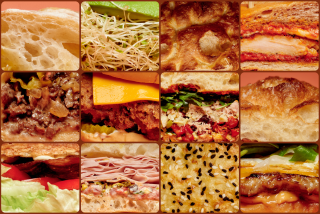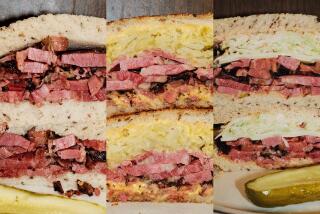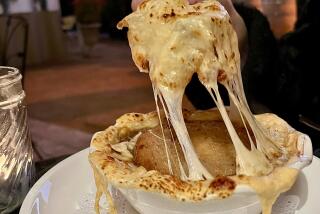The Melting Point
When I first met my husband-to-be, we held hands for months before I noticed the faint discoloration swirled across his left-hand knuckles. âWhat happened here?â I asked, tracing it with my fingertip. âFondue burn,â he replied sheepishly. âFrom the â70s. Or maybe it was the â60s.â
Turns out heâd collided with a wayward pot of fondue bourguignonne. Just another reason to avoid beef fondue at home, I thought. Itâs one thing to dabble in shabu-shabu at a Japanese restaurant, but who wants to deal with a vessel of boiling oil and the food-contact issues of raw beef in their own dining room? Especially when the classic Swiss admixture of white wine, kirsch, and Gruyere cheese remains simple, earthy and utterly without reproach.
Few wonderful things are so spontaneous. The apocryphal story is that fondue originated when a Swiss shepherd, shivering before the campfire, decided to melt his eveningâs ration of cheese and wine in a pot and spear chunks of coarse bread on a branch. One can only imagine his rapture.
Over the years, fondue underwent various refinements. Jean-Anthelme Brillat-Savarin, 18th century French professor of gastronomy, codifies that le vrai fondue fromage contain beaten eggs for smoothness. Similarly, the unctuous fonduta of northern Italy, made with melted Fontina, requires egg yolks. âLarousse Gastronomique,â the definitive culinary encyclopedia, offers regional variations with Comte, Beaufort, Camembert, Pont lâEveque, Fontina, Gruyere and Appenzell cheeses. Many contemporary recipes, including the one here, call for cornstarch to ensure velvety texture, since some cheeses can turn stringy without warning. There is one constant: Good fondue is bolstered with dry white wine and kirschwasser (white cherry brandy). In the interest of festivity, the host may be more or less judicious in the bolstering.
My husbandâs vagueness notwithstanding, Iâve noticed people tend to become evasive when fondue is mentioned. The communal nature of the dish, the intimacy of huddling together around a substance whose consumption produces a certain euphoria--these are retrograde notions to which few will openly admit allegiance. But fondue, after all, is just a deconstructed grilled-cheese sandwich. Add an insouciant dash of alcohol, and youâve got something few Americans can resist.
Nearly every winter, the popular press touts the revival of fondue. But, given the need for special equipment, itâs not an easy sell. Among the current flurry of holiday mail-order catalogs, one features a shocking-purple fondue set--pot, forks, Lazy Susan--on the same page with such gifts as a disco ball and a 33-rpm record turntable. Elsewhere, a pricey copper fondue pot gleams among Charlotte molds, crepe makers and other left-brain gourmet apparatus. The message: Fondue is kitsch, unless you take it seriously. It just depends on your level of confidence. Letâs not even mention chocolate fondue with strawberries, or caramel fondue with apples, or myriad sweet variations on a savory theme. To the purist, fondue will always be synonymous with cheese, and thatâs as good as it gets, especially in the winter glow of an open flame.
CHEESE FONDUE
Serves 4 to 6
(Recipe courtesy of Tyler Florence, Television Food Network)
1/2 pound imported Swiss cheese, shredded
1/2 pound Gruyere cheese, shredded
2 tablespoons cornstarch
1 garlic clove, peeled
1 cup dry white wine
1 tablespoon lemon juice
1 tablespoon cherry brandy, such as kirschwasser
1/2 teaspoon dry mustard
Pinch nutmeg
*
In small bowl, coat cheeses with cornstarch and set aside. Rub inside of ceramic fondue pot with garlic. Over medium heat, add wine and lemon juice and bring to gentle simmer. Gradually stir cheese into simmering liquid. (Melting the cheese gradually encourages a smooth fondue.) Once smooth, stir in cherry brandy, mustard and nutmeg. Arrange assortment of bite-sized dipping foods, such as chunks of French and pumpernickel breads, on Lazy Susan around fondue pot. Some other suggestions are Granny Smith apples and blanched vegetables such as broccoli, cauliflower, carrots and asparagus. Spear with fondue forks or wooden skewers.
More to Read
Eat your way across L.A.
Get our weekly Tasting Notes newsletter for reviews, news and more.
You may occasionally receive promotional content from the Los Angeles Times.










